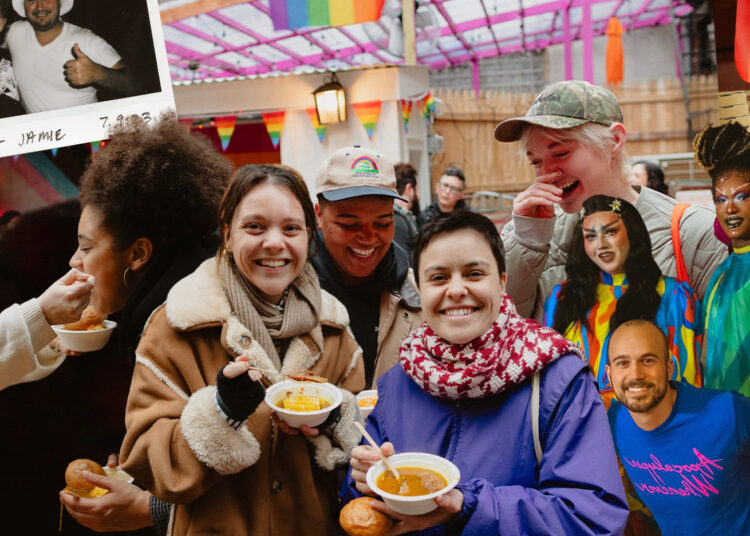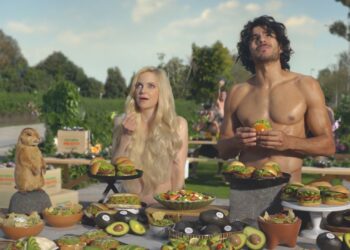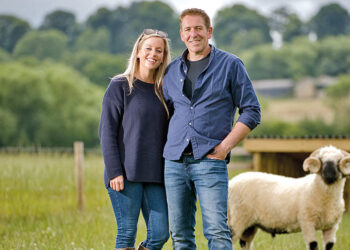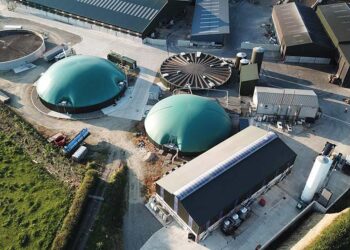Photo illustration by Lille Allen; see below for full credits
The rising popularity and visibility of LGBTQ pop-ups and parties may seem new, but queer people have always found each other everywhere, discretely or otherwise
On the second Sunday of every month, Rosie Tucker and Wolfy Scheckel drive the half-mile from their house to Pizza of Venice in Altadena, California. Altadena, on the edge of the Verdugo Mountains above Pasadena, is not necessarily known as a queer haven — it’s an unincorporated area, home to a bunny museum, a historic Christmas light attraction, and several wilderness trails. But on those second Sundays, Tucker and Scheckel will draw dozens to their neighborhood pizzeria for their Trans Pizza Party. It’s just how it’s described: a night where trans people in the area can come gather at the neighborhood pizzeria and meet other trans people.
Tucker and Scheckel founded Trans Pizza Party a year ago, exhausted by the unrelenting news of anti-trans legislation emerging nationwide and the online discourse surrounding it. The Altadena locals and musicians wanted to find a low-stakes way of meeting other trans people near them. “We thought about how great it is to show up in the same place at the same time, making connections in person,” Tucker says. “We wanted to make something that couldn’t be branded, that was expanding the queer universe in a very chill direction, very near to us, removing any vibe of a barrier, and saying, ‘Here’s a super chill queer time near you.’”
About 20 miles from Pizza of Venice lies West Hollywood, home to a thriving queer scene. Los Angeles is abundant with LGBTQ bars and clubs, drag venues, and parties; none of them appeal to Tucker and Scheckel, not in the way they used to. “There are so many queer events happening every single day in LA; I’m not going to any of them,” Scheckel says. “I don’t drink, I don’t do drugs. I’m 31, Rosie just turned 30, and we’re at a place in our life where our personalities are not that.”
The diversification of explicit queer spaces has seeped into every facet of social existence, beyond clubs: natural wine bar pop-ups, aperitivo nights, third culture supper clubs. Some parties, like Coqta and Hotpot in Los Angeles, focus on specific underserved groups within the larger queer community. Others focus on the dishes offered, things like pizza or vegan wings or soup. Some of these events are for-profit pop-ups, their organizers dreaming of opening restaurants or bars in the future; others are very much not businesses, fundraising for mutual aid projects or simply gathering to build community. The through line is an explicit queerness, a choice to identify as — and signal to — a specific audience.
Wolfy Scheckel
Images from past Trans Pizza Party events.
Wolfy Scheckel
While working on his book Long Live Queer Nightlife, professor Amin Ghaziani spent years attending and interviewing the organizers of queer club nights, parties, pop-ups, and events in London. He talked to Londoners throwing Jewish theme parties at clubs offering bagels at the door, Spanish theme nights with tomato-wrestling competitions. He would ask all of his subjects the same question: “What is a queer space?”
The answers he heard in response were not clear, though he didn’t expect them to be. The themes he heard again and again emphasized the murkiness of defining queerness, let alone queer space. “These queer spaces and places are experimental, they’re non-normative, non-mainstream, they have a progressive politics, they espouse a politics of intentional inclusion, and they’re very much intersectionality-driven spaces,” he says. “They’re less about creating something finite and clean. Queerness has a history defying fixed categories, and part of the beauty of queerness is that it cannot be fixed. Those themes that I’m offering, you could think of them as gestures of queerness.”
Nonetheless, the defining of queer space has been the subject of decades of study. Jaime N. Hartless, an assistant professor at Farmingdale State College, originally defined queer space based on specific tenets, like aesthetics, branding, and function; over the course of her career, however, as she spoke to more queer people, she says her understanding of what qualified as a queer space became “increasingly fluid, increasingly contested.” Greggor Mattson’s definition eschews the standard of specificity. Mattson, an Oberlin professor and the author of Who Needs Gay Bars?: Bar-Hopping through America’s Endangered LGBTQ+ Places, identifies queer spaces as places that simply “reproduce queer culture … places outside the work space and the birth home where we find out how to be in the world.”
These answers, however, likely vary from the average queer person’s definition. Many think of places like the typical gay club, leather bar, or drag venue. To others, maybe the idea evokes images of New York’s Everard Baths of the early 20th century, or historic lesbian cafes like Mother Courage, Brick Hut Cafe, or Bread and Roses. Those disparate versions of queer space are, in part, a result of its shifting working definitions: Over time, more specific identities under the broader LGBTQ umbrella found solace in spaces catered to them, particularly as tensions between gay and lesbian communities waxed and waned over time.
Queer spaces were primarily developed and guarded as the only places queer people could live freely without fear of violence or legal persecution. “The history of queer spaces began during a time when society was generally more homophobic and transphobic,” Hartless says. “Of course, society is still very homophobic and transphobic, but at the time, these were the only safe queer places.”
Until relatively recently, queer spaces were inherently ephemeral and transitory, popping up in straight spaces at different times of day — or in the presence of straight people. “Before we had durable, 24/7/365 queer spaces, we had spaces that were ostensibly straight during most parts of the day or week, and queer people would take them over at night,” Mattson says. Think of diners, the site of countless post-drag dinners and musical theater cast parties; think of boardwalks, parks, hotel bars, and bathrooms where gay men would cruise after dark.
Erik Piepenburg, who has been researching gay restaurants while working on his book Dining Out, to be released in spring 2025, thinks specifically of the automats of the early 20th century, where gay men would often meet each other amid groups of families and straight workers on lunch breaks. “Those were spaces that were not queer identified in any way, but gay people knew how to identify one another,” he says. “Glances were coded. They were sort of proto-gay restaurants, because they were open to everyone. Gay men knew how to make it their own, under the radar of straight people.”
According to Piepenburg, many restaurants that had attracted gay diners increasingly began to identify as gay restaurants after the Stonewall protests, considered the site of one of the most revolutionary queer uprisings in American history. “You could look at a space like Hamburger Mary’s, which opened in the ’70s, that really said, ‘This is gay church.’”
The rise of the gay bar, as laws outlawing “indecent behavior” sloughed their homophobic standards, allowed for a revolution of queer congregating. Bars and clubs emerged as crucial third places during the HIV/AIDS pandemic for fundraising, activism, or “joyous resistance” for queers in need of a home. “Historically we’ve had spaces other than bars — bathhouses, diners, beaches, bookstores, YWCAs, etc.,” Mattson says. “But nightlife was one consistent place where we were tolerated and where we made shared meanings that gave rise to LGBTQ+ culture, and bars were by far the most common institution.”
But as the broader, heteronormative culture began to interact with those spaces, they became one of the only ways the straight public understood queerness. On film and TV, gayness is portrayed as a never-ending party fueled by Jell-O shots, neon mesh, and Kylie Minogue. “Historically, cis white gay men have dominated gay nightlife scenes, in terms of the spaces available to them, the type of visibility we would see, the voices prioritized during annual pride celebrations,” Ghaziani says. “Everyone else was presented as a tiny minority. … This is not to demonize cis men; there are simply communities now that are trying to center other experiences.”
As being out became relatively less of a life-threatening endeavor, queer people began to find each other in different ways, particularly online. And, for reasons that are hard to pinpoint, brick-and-mortar LGBTQ bars started to rapidly shutter. According to Mattson, 45 percent of American gay bars closed between 2002 and 2023, with 15 percent of those closing just due to the COVID-19 pandemic.
In the perspective of Adam Nathaniel Furman, the co-editor of Queer Spaces: An Atlas of LGBTQIA+ Places & Stories, the loss of brick-and-mortar queer bars is not necessarily a signal of diminishing queer spaces as a whole. Alongside co-editor Joshua Mardell, they explore queer spaces globally throughout history, which include book clubs, palaces, theaters, and countless pop-up events and parties. In their perspective, the alarms over the loss of gay bars ignore the countless other queer spaces that have emerged throughout history and in the current era.
“It’s expanded outside sex and partying, with book shops and cafes and other spaces. New queer spaces that are more about communing, conversation, that does seem to be quite international,” Furman says. “No matter what country you’re in, queer people come together and create spaces. When they can’t find spaces, they create secret events, they create zines — they always find a way.”
At Portland, Oregon’s Jacques Strappe, bears in leather thongs mingle with dudes in T-shirts, sipping Champagne from coupe glasses. The event, which began in February 2020, right before the onset of the pandemic, has changed over time, shifting from a sultry dance party into something more casual, where queer people snack on nonna-style pizza and tacos. Founder Christopher Sky, one of the winemakers behind Hooray for You, came up in both Seattle queer bars and Portland’s fine dining world. He has attended many raucous parties over the years, but he wanted Jacques Strappe to be something different, something intentionally luxurious. In the last year, he allowed himself to explore what Portland wanted Jacques Strappe to be, trying out different ideas and involving the art and perspective of other queer people in the city. “It was literally underground, a sexy cocktail Champagne caviar dance party in a basement that felt secret and special,” he says. “It has evolved a bit and I’ve had fun playing around with different ideas and different spaces, which I think is a plus of this pop-up format.”
The vacuum left by the closure of queer bars has made space for a broader playfulness in how queer people congregate: It “can inspire not the decision to replicate,” Ghaziani says, “but the idea to do something different. It offers the opportunity for reinvention.” And many have been able to capitalize on the growth of interest in pop-ups to develop concepts without the capital required to start a more “traditional” restaurant — an often high barrier to entry, particularly for those in marginalized groups.
Christopher Sky
Scenes from a Jacques Strappe party in Portland, Oregon.
Christopher Sky
These events are not necessarily new, however; rather, the disruptions of the past few years have more clearly exposed them to the broader queer community. “The point here is not that it’s unique, but rather uniquely revelatory,” Ghaziani says. “That helps us appreciate that what’s happening today in London ties into a long, rich, international history of queer people using the temporary format to meet several social, political, and cultural needs.”
For some, the isolation of early COVID-19 lockdown inspired them to build more specific queer spaces in their physical area, away from the warped mirror of the internet that became their office and all-encompassing third space. “Part of resilience is having your people near you,” Tucker says. Tucker’s appreciation for physically spending time with other trans people has only grown as they have toured as a musician, encountering trans communities in parts of the country where being out can be physically and legally dangerous. “It has been such a rewarding thing, going from state to state, no matter what state we’re in, to be in a room full of trans people. It’s important for understanding the stakes.”
For Scheckel, building that queer community at home also felt vital in terms of challenging the idea that queer people are only isolated to specific, financially inaccessible areas. “In LA, the queer neighborhoods are the most gentrified neighborhoods, the expensive neighborhoods where people can’t live without a trust fund,” Scheckel says. “People come to Trans Pizza Party from Redlands, people come from Culver City. Queer spaces are wherever queer people are, as long as they’re looking out for each other.”
As these queer events have emerged in so many different spaces, including straight-owned ones, queer communities and allies have had more opportunities to build more intentional solidarity. In states where alt-right groups have threatened drag queens and protested drag shows, where anti-trans legislation has made queer gathering feel more dangerous, and where aligning yourself with specific queer communities can make you a target by association, business owners lending their spaces to queer groups can be an important form of allyship.
For example, Cleveland LGBTQ dance club Bounce closed in 2017, leaving several area drag performers without a regular venue for shows. In response, several different types of bars began their own drag nights to fill the void. “Smaller bars, gay bars that had never had drag, had drag all the time, and all the performance spaces in town started having drag shows,” Mattson says. “I don’t know if this is queering straight spaces, or if maybe some spaces are becoming post-straight.”
One of the most well-known — and perhaps farthest reaching — queer food events in the United States is Queer Soup Night, created by Liz Alpern in Brooklyn in 2017. Alpern hosted a soup-fueled fundraiser at the now-closed Pels Pie Co., which became a recurring event. Over time, Queer Soup Night expanded, with chapters springing up across the country: Salt Lake City, Cincinnati, and the Hudson Valley all have their own events. The newest Queer Soup Night was held in Asheville, its first in North Carolina; Vermont will host its first Queer Soup Night in mid-June.
Queer Soup Night allowed Alpern the freedom to explore not only alternative queer spaces, but also alternative models for pop-ups, resisting capitalism. “Everyone can have a platform through social media, everyone can try things out,” she says. “Maybe not everyone can open a brick-and-mortar restaurant. I’ve always wanted to do this queer soup pop-up, but I knew it wouldn’t be profitable. Then it came up with the idea of, ‘Oh, what if it’s a fundraiser?’ All of a sudden, it makes sense.” Since 2017, Queer Soup Night has raised money for organizations like the Astoria Food Pantry or the NYC AIDS Memorial, collaborating with guest chefs like DeVonn Francis and Edy Massih.
G Caliolo Photography
Cocktail writer and industry vet Al Culliton used to go to Queer Soup Night when they lived in New York; when Culliton moved back to Western Massachusetts, however, they decided to bring Queer Soup Night with them. “When I was 21, newly in queer community, I definitely considered people in their 30s and 40s or even late 20s to be my guides and models for what one could be in the world,” Culliton says. “I was thinking about what we could do to bring people together, thinking back to the multigenerational AFAB [assigned female at birth] queer community I came up in Northampton, Mass. I wanted to show people what it looks like to be queer in your 40s and gender-divergent.”
Culliton first moved to Western Massachusetts for college, and quickly fell into jobs within the service industry. Working at a coffee shop, they started to meet more queer people and develop a community; when they became a manager, they hired more queer people, shifting the identity of the cafe itself. “I sort of queered this coffee place, this place that was groovy, hip, but wasn’t that gay,” they say. “I made it really gay.”
Beyond a Western Massachusetts Queer Soup Night, Culliton hosts queer nights and butch fashion shows at the straight-owned bar where they work, Gigantic. People will drive upwards of 30 to 50 miles to go to the Western Massachusetts Queer Soup Night, as well as Culliton’s other queer events. “There is a lack of queer community spaces that are truly inclusive in our area,” they say. “There’s a great opportunity to get some folks involved that have been displaced from some of the less inclusive spaces [here].”
So if queer spaces are less specific about essential characteristics — who is straight, who is gay, how they present, who owns the space — the question becomes: What does matter? For many, it has to do with making space for true, consistent community-building, both within the queer community and with the community at large. That comes down to both how owners, regardless of orientation or identity, create and support their queer audience, both culturally and politically. But it also includes how queer people get to interact with each other, in niche ways and in broad ways.
Linneas Boland-Godbey, the Portland, Oregon-based founder of drag event company Rose City Drag and producer of several BIPOC queer events across Portland, consistently works with straight-owned businesses when organizing their events. For him, community-building means paying performers well, investing in making sure the space is safe for their patrons and queer performers, and consistently showing up for and investing in the queer community. “Portland is predominantly queer, in more ways than one,” they say. “For us, to really understand and work together, we have to make sure there’s space for everybody, that everyone’s accepted in those spaces.” Practically speaking, that could play out via asking customers for their names as opposed to reading a name off an ID or credit card, asking for pronouns, and having staff know how to de-escalate or shut down incidents of harassment if they were to arise.
But while these pop-ups and events can temporarily make any space queer, they’re also by design unable to create more consistent sites of support — a lack that feels particularly acute with the continued loss of more permanent gay bars. This inconsistency can be particularly challenging for those who are currently isolated and can’t get to a bar the one night a month they throw a party.
“One of the downsides of these temporary brief spaces is that they’re harder to find,” Hartless says. “You sometimes have to be in the networks to know they’re happening. Sometimes they show up on Google, but maybe not. The downside of being ephemeral is that it’s harder to touch, easier to miss.”
Queer spaces are ephemeral, businesses are ephemeral, we are ephemeral as human beings. What outlives us is queerness, the foundations we build and the ways a community can outlast us. Queers and their allies have always built community as an act of survival — not only in terms of resilience but also as a way to own and celebrate queer joy, to be reminded of how beautiful it is to be a queer person. “The idea of traditions, of continuity, the creation of memories which can then be archived, shared, treasured is hugely, hugely important,” Furman says. “The idea that you’re creating ceremonies and events, that’s just as vital as any brick-and-mortar space.”
Trans Pizza Party recently celebrated its first anniversary — the first pizza party Tucker and Scheckel couldn’t attend. Still, trans people gathered at Pizza of Venice, ordered their pies, and hung out. That’s exactly what they were hoping for: something that could exist without them. “No one knows who we are at this party anymore,” Scheckel says. “We’ve made our friends there. The others, they think of it as this magical space; they don’t know we’re there. We don’t have to be there, though we want to be there. We love the people who show up.”
Additional photo illustration credits: Polaroid-style photo of Trans Pizza Party by Wolfy Scheckel; Queer Soup Night photos by G Caliolo; group shot of Rose City Drag by Linneas Boland-Godbey














